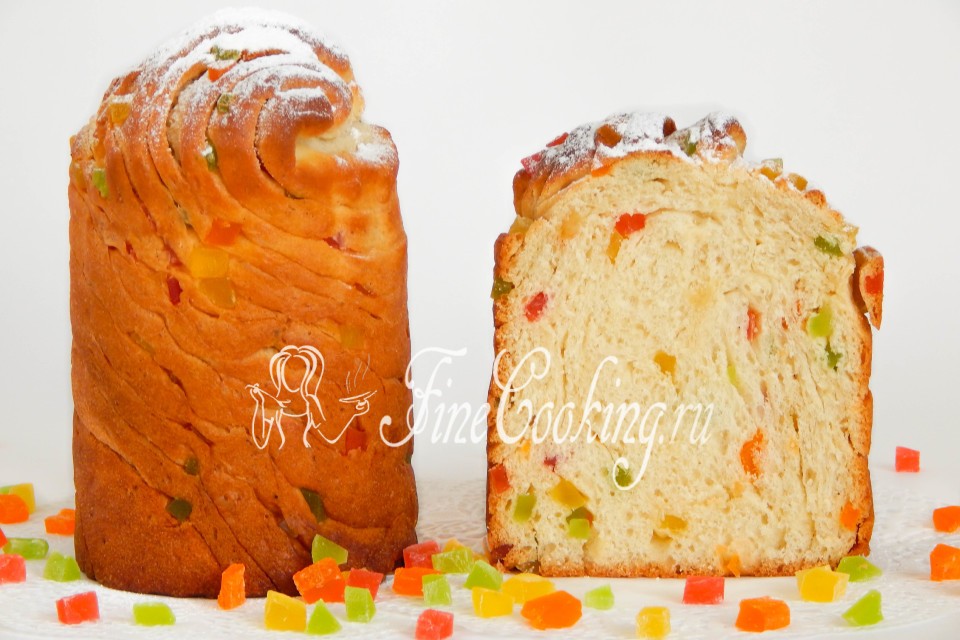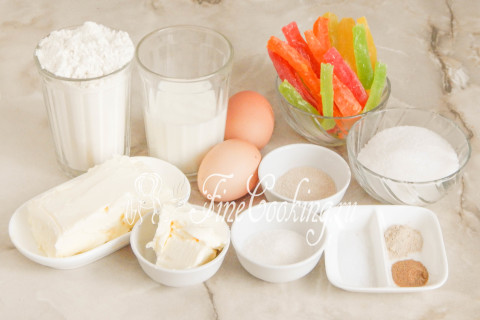Step 1
For the preparation of unusually tasty, delicate and fragrant Easter cakes, we need: wheat flour of the highest grade, milk of any fat content (I use 2.5%), sugar, medium-sized chicken eggs (45-50 grams each), butter (with a fat content of at least 72%), tsucrats, vanilla sugar (you can replace 1 tablespoon with a tablespoon Sugar-sand and generous pinch of Vanilin), yeast, salt. In addition, I advise you to add spices to taste and desire — I have ground cinnamon and cardamom.
Step 2
Sift (preferably twice) in a bowl of the highest grade (I put the whole amount at once). Due to this, the flour is not only loosened and saturated with oxygen, but possible garbage will also leave. Perhaps you need a little less or more flour — it depends on its quality (in particular humidity). That is why I would advise you to use not all the flour at once, but take 300 grams to begin with — then you will navigate the consistency of the dough. Add fast yeast to flour (6 grams are 2 teaspoons under the knife) and half a teaspoon of small salt.
Step 3
Mix everything thoroughly with a fork or a whisk. About yeast: it is not necessary to take precisely fast -acting ones — just dry (also 6 grams) or pressed (3 times more, that is, 18 grams) are perfectly suitable. Such yeast is not immediately mixed with flour, but previously activated in a warm sweetish liquid for 10-15 minutes. In our case, you can slightly heat 110 milliliters of milk with a tablespoon of vanilla or simple sugar and dissolve yeast in it.
Step 4
In a separate dishes, break a pair of chicken eggs, add 90 grams of sugar and a tablespoon of vanilla sugar.
Step 5
Beat everything with a mixer at high speed for about 5-7 minutes so that the sugar completely dissolves, and the mass becomes light and airy.
Step 6
Add 110 milliliters of slightly warm milk to sweet whipped eggs and pour a dry mixture (flour, yeast, salt) from step 3 there.
Step 7
We mix everything until the flour absorbs the liquid — you can with your hands, you can with a mixer with a hook nozzle. It turns out a very soft and sticky dough — it is still loose and not homogeneous. Now in parts you need to introduce 50 grams of soft butter into this dough, literally on a teaspoon. Remove the oil in advance from the refrigerator and let it warm up a couple of hours on the table.
Step 8
After the complete administration of the oil as a result of a rather long (at least 10-12, or even 15 minutes with a mixer with a nozzle-bag) and intense batch you will receive a delicate, incredibly soft and elastic dough. With hands, such a wet dough is mixed according to French technology (stretching-stooping), and even longer-about 15-20 minutes. You need to knead until the dough stops sticking hard to your hands!
Step 9
We round it and shift it into dry and clean dishes, quite slightly lubricating it with refined vegetable oil (simply so that the dough is not stuck). Tighten the bowl with cling film or cover with a lid and send to a warm place for 40-60 minutes (in the original). My dough rose poorly (yeast came across poor quality), so I kept it warm for 1.5 hours.
Step 10
During this time, we will prepare the centers that need to be cut with a small cube. If you want, use the same amount (150, up to 200 grams) of dried fruits (dried apricots, prunes, raisins, dried cherries or cranberries) or nuts (almonds, hazelnuts and others).
Step 11
When the dough increases in the amount of two times, it will need to be sprouted.
Step 12
Next, you need to divide the dough into as many parts as you plan to bake in Easter cakes. I decided to make 2 rather large ones, so I divided the dough in half. We round each piece, roll into a ball and put on a working surface, drunk with a small amount of wheat flour.
Step 13
We cover the dough with a cling film or a light towel and let it rest for 10-15 minutes, so that during this time the koloboks relax and it is convenient to work with them.
Step 14
Next, lay out one part of the dough on the working surface, slightly drilled with wheat flour. This yeast dough is very malleable and elastic, but still a little flour will be needed (it did not indicate in the ingredients). With the help of a rolling pin, rolls the dough into a rectangle as thin as possible — ideally with a thickness of not more than 3 millimeters.
Step 15
Lubricate the dough layer with very soft butter — it took me exactly 100 grams (50 grams per blank) for 2 cakes.
Step 16
Right with your palm evenly spread the oil over the dough.
Step 17
On all surfaces, we distribute crushed centers (half of the weight) and sprinkle through the sieve fragrant spices (I have cinnamon and cardamom).
Step 18
It remains to carefully twist the layer of dough into a dense roll. Do not forget that you need to twist from the narrow side.
Step 19
Gently pinch the seam and turn the roll on it. It is not necessary to pierce the seams from the edges!
Step 20
Similarly, we form the second (or you will have so much) roll. We give the workpieces to rest for 10 minutes under the film.
Step 21
Then we need a very sharp knife to cut the rolls along the 2 parts. Just do not cut to the very end — leave a centimeter 3.
Step 22
The molding of Kulichi-craffins is quite simple: we begin to twist the half rolling roulette so that the incision is from the outside.
Step 23
So we twist the entire workpiece, and insert the tip into the center and slightly push inward. Thus, when decorating and baking, Easter cakes will retain a beautiful hat. Similarly, we form a second snail from yeast dough.
Step 24
Now you need to put the blanks in baking molds. I used 1 detachable form (10×10 cm) and a tin can — 9.5×11.5 cm. Since the forms are metal, they need to be laid with parchment paper. For this, first of all, I lubricate the forms with a thin layer of refined vegetable oil — it will help to stick paper and hold well. At the bottom I put a circle of paper, which I measure in advance. Well, the walls are just a cut (above the sides by 3-4 centimeters) of parchment paper, which I turn and insert into the shape. I press to the walls — thanks to the clock, they stick and are not deformed. That is, the dough does not apply to the oil, it grows, clinging to the paper. We cover the molds with cling film and leave in a warm place for proofing for 1-1.5 hours.
Step 25
Ideally, Easter cakes are placed in the oven, when about 1.5-2 centimeters remain to the top of the forms, so that they still have where to grow. The top of the workpieces does not need to be lubricated, since the baking contains a lot of butter — it will brush the caps.
Step 26
Additionally, I advise you to wrap the bottom of the detachable shape with a cut of the food foil, since the oil in the test during the baking can flow, then it will drip to the bottom of the oven and bell.
Step 27
We bake the future cakes of crafins in a preheated oven for the first 10 minutes at 200 degrees, after which we reduce the temperature to 175-180 degrees and bake for about 35-40 minutes. The cooking time directly depends on the size of the shape and features of the oven. We check the readiness for dry beam — a wooden toothpick is dry from the dough, the Easter cakes are ready.
Step 28
Easter cakes in paper forms are left: decorate and remove the packaging only when eating pastries. Those cakes that were baked in metal forms, cool in them for about 10 minutes, after which we take out and release from parchment paper. It is easily removed and does not catch the finished dough with it — the Easter cakes are neat, tidy and very spectacular. Just look what handsome people! It is necessary to decorate the cakes-carffons with sugar powder (1 tablespoon per 2 cakes is enough), since the glaze will simply hide their grace.
Step 29
Guess how long my Easter cakes cool before I cut them? 20 minutes, no more! They smelled so much that there wasn’t the strength to wait … By the way, the incision of the kulich-crafin is even and neat even in a warm state. Crushing crust, delicate, fibrous crumbs, sweet pieces of centers — fabulous Easter pastry. Prepare for health, friends, and on the upcoming holiday you!
Step 30
Easter-2017. Double norm of products, 5 large cakes. A delightful pastries!
Step 31
Easter-2018. Double norm of products, 4 high cakes (small diameter forms). Today I wanted experiments, so I used pressed (fresh) yeast and put dough. The dough during baking has grown 4 times! Not only tsukata became the filling — she replaced part with fried almonds, raisins, dried cherries, and homemade zuccations made of orange crusts. Everything (except almonds) soaked for a day in dark roma — the aroma indescribable!































